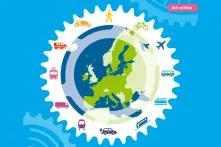
Europe and the world have been hit by transnational crises before the Covid-19 pandemic. And mostly all of them had a severe impact on mobility and transport.

By no means can the pandemic be compared to the monstrosity of the two World Wars, which also elude any comparison as to their effects on mobility. At the end of the Second World War, Europe and the world were split up into two blocs, which resulted in the creation of parallel transport industries and infrastructure. Infrastructure would usually end or at least be obstructed at the blocs’ borders. Travelling from one side of the border to the other would usually only be possible indirectly, if at all.
The Covid-19 pandemic is more comparable to crises such as the 1970s energy crisis or 9/11. The 1970s energy crisis, with its strong increase of global oil prices, resulted in halts of automobile traffic all over the world. Some western European countries introduced temporary speed-limits and car-free days. For the Netherlands, the crisis was the kick-starter for becoming one of the most bicycle-friendly nations in the world. 9/11 resulted in a temporary crash of the aviation market. While the general dependency on oil continues to exist, the Covid-19 crisis is more comparable to 9/11, in terms of its effects on the world economy and more specifically to mobility and transport.
The pandemic has already led to a crash in the aviation market. In April 2020, air traffic across Europe plummeted to ten percent of normal levels. Airlines are trying to re-boost their business during holiday seasons by claiming that, despite the impossibility of applying distancing rules on board aircraft [or aeroplanes, or just planes] flying does not entail a higher risk of a Covid-19 infection. These desperate claims are accompanied by 34.4 billion euros in state aid and counting.
While air traffic was almost grounded at the beginning of the pandemic, nearly all rail companies kept their services up and running to provide essential transport. Trains were partially limited to borders and the number of trains was reduced in some countries, while in others, normal services were maintained in order to allow for better distancing. Public transport has suffered a substantial decrease of passengers, which in the medium term will lead to a serious impact on its financing.
One of the few clear winners of the pandemic is the bicycle. Sales have sky-rocketed during the lockdown, since people seem to consider the bicycle to be a safe alternative to public transport, with which distancing and keeping fit come naturally.
For longer journeys, the car became the most popular means of transport (again). Yet sales of cars have suffered heavily, due both to an interruption of car manufacturing supply chains and the economic uncertainty felt by the consumers and potential buyers.
The Covid-19 pandemic also had a strong impact on public space. Obviously, shopping streets have been hit hard by the immediate effects of the pandemic, especially the lockdown. They will continue to suffer from distancing rules. Public space is literally gaining ground in terms of an increased use for exercise, play and recreation. In general, the need for increased public space exceeding the pre-existing political demands has emerged as a result of the pandemic.
Although the immediate impact of the pandemic on mobility goes further than the conventional means of transport, those are among the main aspects that citizens experience in their everyday lives.
In the long run, the economic crisis that came with the pandemic and the national and international recovery measures will be more decisive. Climate change is looming, therefore governments need to take comprehensive decisions, combining solutions for the economy, the people and the planet.
The EU is focusing its Multiannual Financial Framework and the Next Generation EU funds on the recovery from the Covid-19 crisis. EU Member States have taken up a range of measures (such as the aforementioned bailouts for airlines) in order to overcome the most negative impacts of the pandemic. As the draft proposals show, transport is only a minor aspect of these recovery efforts. Yet the efficiency and the focus of the measures taken in this regard will shape societies for a long time to come.
Positive signs are the green conditionality of the airline bailouts in Austria and the German rejection of the so-called Kaufprämie (buyers premium) for conventional cars.
Sources for data and graphics: Forschungsbereich für Verkehrsplanung und Verkehrstechnik (TU Wien), COVID-19 und Mobilität: Ergebnisse für Österreich, https://bit.ly/31V0n5H; European Cyclists' Federation, COVID-19 Cycling Measures Tracker, https://bit.ly/3oCflqW; EUROCONTROL, Daily Traffic Variation, https://bit.ly/2TBOdKo



